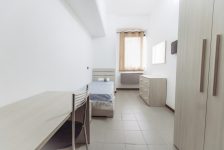World’s Best Prison

We’ve written previously about the toughest prisons in Australia, as well as Indonesia’s plan to use crocodile infested waters as a security feature in their proposed maximum security gaol.
But on the other end of the scale, Halden Fengsel prison in Norway may just take the prize for to the best prison in the world.
It has been called the world’s most humane prison – and is reportedly so good that no inmate has ever even tried to escape!
One American journalist who visited the prison noted the absence of razor wire, electric fences or watchtowers, although it is surrounded by a 20 foot concrete wall.
There are no surveillance cameras in cells, hallways or most workshops – and the prison boasts a fully equipped gym, complete with a rock-climbing wall. It also has a recreation area, a hobby centre and offers a range of classes, from pottery and cooking.
Each cell has a private ensuite bathroom, flat screen TV and mini-fridge.
Inmates can go for nature walks in nearby woods and a million-dollar mural adorns one prison wall, painted by famous Norwegian graffiti artist Dolk.
Working in a Norwegian prison
And it’s not just the inmates who are looked after – Norwegian prison officers receive two-years of fully paid training in criminal law, psychology, human rights and ethics before beginning work at the prisons.
This compares to just nine weeks pre-service training in NSW for correctional officers, and as little as six or seven weeks in other Australian jurisdictions. Prison staff are not armed and 40% are women; which is believed to decrease aggression.
Philosophy Behind the Norwegian Prison System
Perhaps the most well-known inmate in Halden Fengsel is Anders Behring Breivik, the Norwegian man who killed 77 people during a 2011 attack.
Internationally, many were shocked that the perpetrator of such a heinous crime could receive a prison sentence of just 21 years. They were even more outraged by the fact he will serve his time in relative luxury.
Norway’s prisons are geared towards rehabilitating inmates, rather than simply punishing them. The Norwegian Correctional Service website expresses the view that taking away a person’s liberty is punishment enough – and prison is not a place to receive further punishment.
Security in Norwegian prisons must not be any stricter than necessary for the security of the community, and inmates retain almost all of their pre-custodial rights and privileges.
Arne Wilson, a clinical psychologist and governor at Bastoy Fengsel (another Norwegian prison), explained the Norwegian approach to The Guardian:
“In closed prisons we keep them locked up for some years and then let them back out, not having had any real responsibility for working or cooking. In the law, being sent to prison is nothing to do with putting you in a terrible prison to make you suffer. The punishment is that you lose your freedom. If we treat people like animals when they are in prison they are likely to behave like animals. Here we pay attention to you as human beings.”
By contrast, liberty is not the only privilege removed from inmates in Australia – even the right to vote is taken away in some circumstances. And just last year, the smoking ban in NSW prisons deprived many inmates of their favourite way to de-stress and relax.
Does it work?
Norway has one of the lowest rates of recidivism in the world– just 20% of inmates commit a further offence within two years of release.
By contrast, over two-thirds of US inmates were re-arrested within three years of their release. And in NSW, more than half of those who commit an offence will commit another within 10 years.
In Norway, inmates make up just 75 out of 100,000 people, while in the US, this figure is 707 out of 100,000. The imprisonment rate in Australia is 196 per 100,000, and our prison population is constantly rising, despite the fact that crime rates are declining.






